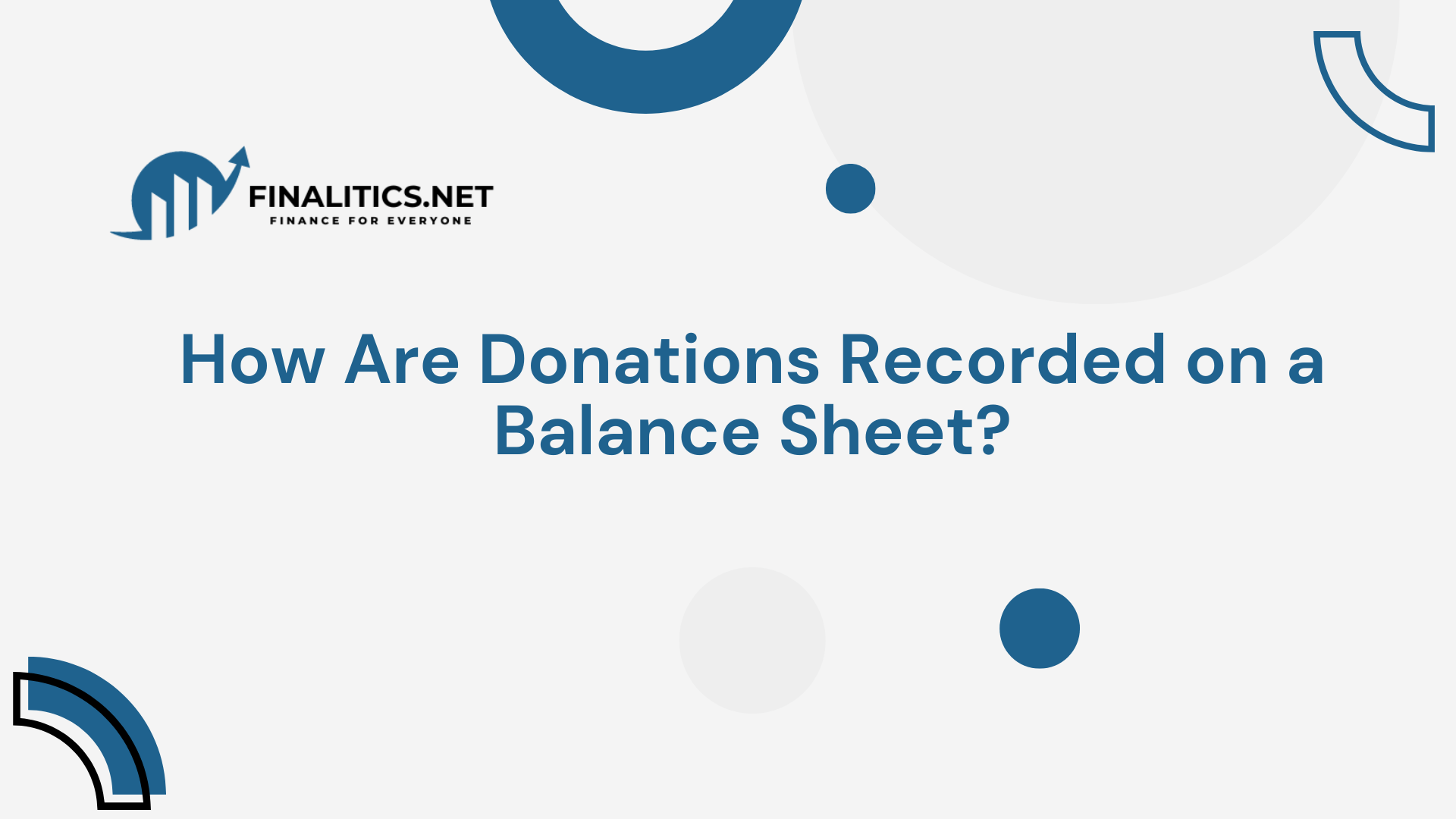This article explores how are donations recorded on a balance sheet, breaking down the different types of donations, their implications, and the accounting standards that govern them.
Table of Contents
- Understanding Donations in Accounting
- Types of Donations and Their Classification
- How Donations Appear on the Balance Sheet
- Where Donations Are Calculated on the Balance Sheet
- Accounting Standards Governing Donations
- Example Entries for Recording Donations on a Balance Sheet
- Challenges in Donation Accounting
- Conclusion
In the financial management of both for-profit and nonprofit organizations, donations represent a significant source of income. However, the way donations are recorded on a balance sheet differs based on the type of organization and the nature of the donation. Accurate recordkeeping of donations is essential, as it impacts financial reporting, compliance, and transparency.
Understanding Donations in Accounting
Before understanding how donations are recorded on a balance sheet we need to understand donations first and their types. Donations can be cash contributions, non-cash items (in-kind donations), or services provided free of charge. Each type has its own accounting treatment. Donations are typically seen in nonprofit organizations as they rely on such contributions to fund their missions. For-profit organizations, while less common recipients of donations, may occasionally receive them, often as grants or gifts from affiliated entities or philanthropists.
The way donations are recorded on the balance sheet is governed by Generally Accepted Accounting Principles (GAAP) and International Financial Reporting Standards (IFRS), which ensure financial transparency and accuracy.
Types of Donations and Their Classification
a) Cash Donations
- Definition: Cash donations are contributions made in monetary form. This is the simplest form of donation and is often the most common for nonprofits.
- Recording: Cash donations are recorded as “Revenue” under the donations or contributions category on the statement of activities (for nonprofits). They may also increase cash and cash equivalents on the balance sheet.
b) In-Kind Donations
- Definition: In-kind donations include non-monetary items, such as equipment, supplies, property, or even intangible assets like software licenses.
- Recording: In-kind donations are recorded as assets on the balance sheet, typically under current or non-current assets based on their nature and intended use. They are also recorded as income in the statement of activities or income statement at their fair market value.
c) Donated Services
- Definition: Donated services involve professionals providing services without charge, such as pro bono legal advice or consulting.
- Recording: According to GAAP, donated services are only recorded if they create or enhance a non-financial asset (e.g., construction services for a new building) or if they require specialized skills (e.g., legal or medical services). These are recorded as income and a corresponding asset or expense in the financial statements.
d) Restricted vs. Unrestricted Donations
- Restricted Donations: Donors may specify that their contributions are used for specific purposes, like funding a particular program. These are recorded as restricted net assets.
- Unrestricted Donations: Unrestricted donations can be used for any organizational purpose. They are recorded as unrestricted net assets, and their impact appears directly in the statement of financial position or balance sheet.
How Donations Appear on the Balance Sheet
Donations appear on a balance sheet primarily as part of net assets or equity, depending on whether they are restricted or unrestricted. Here’s a detailed look at how they are classified:
a) Net Assets for Nonprofits
- Nonprofits use net assets instead of “equity,” categorizing donations under net assets on the balance sheet.
- Net assets are broken into three types:
- Unrestricted Net Assets: Includes donations with no usage restrictions.
- Temporarily Restricted Net Assets: Donations with a time or purpose restriction.
- Permanently Restricted Net Assets: Donations that must be maintained permanently, often in the form of an endowment fund.
- Cash donations increase net assets by adding directly to the appropriate category based on donor-imposed restrictions.
b) Assets and Liabilities
- Donations that increase cash or non-cash items are recorded as assets. For example, a cash donation increases the “Cash” asset line, while an in-kind donation increases the “Property and Equipment” asset line or other relevant category.
- For restricted donations, a liability account may be used initially to record obligations related to donor-imposed restrictions.
Where Donations Are Calculated on the Balance Sheet
To understand how donations are recorded on a balance, you need to know how donations impact several areas on the balance sheet, depending on the type and any restrictions attached. Here’s a breakdown of where donations are calculated:
1. Net Assets (or Equity) Section for Nonprofits
- For Nonprofit Organizations: Donations primarily affect the Net Assets section of the balance sheet, which represents the difference between the total assets and liabilities. This is where nonprofits display their financial health and categorize donations based on restrictions. The Net Assets section is typically divided as follows:
- Unrestricted Net Assets: Unrestricted donations are included here, allowing the organization to use these funds for general operations.
- Temporarily Restricted Net Assets: Donations with specific time-based or purpose-based restrictions are recorded here and remain until the restriction is satisfied.
- Permanently Restricted Net Assets: Donations intended to be kept in perpetuity, like endowments, are reflected here. These funds are preserved long-term, with only the generated income used for designated purposes.
2. Assets Section
- Donations, especially cash and in-kind contributions, increase the Assets section directly:
- Cash Donations: These donations appear under the Cash and Cash Equivalents line item, immediately increasing the organization’s cash position.
- In-Kind Donations: Physical or tangible donations are recorded under relevant asset categories, such as Property and Equipment, Inventory, or Intangible Assets. For instance, if a company donates office equipment, it will be listed as part of Property and Equipment at fair market value.
- Current vs. Non-Current Assets: The asset classification depends on how long the organization intends to use the donated items. Cash and consumable goods are typically current assets, while donated property or equipment used for long-term purposes are categorized as non-current assets.
3. Liabilities Section (for Certain Restricted Donations)
- In some cases, temporarily restricted donations with specific obligations may initially be recognized in the Liabilities section until the restrictions are met. Once the restriction is fulfilled, these amounts are reclassified to the Net Assets section.
Accounting Standards Governing Donations
a) GAAP (Generally Accepted Accounting Principles)
- GAAP requires nonprofits to categorize net assets into unrestricted, temporarily restricted, and permanently restricted sections. It also mandates that all forms of donations be recorded at fair market value.
b) IFRS (International Financial Reporting Standards)
- IFRS doesn’t specifically distinguish between restricted and unrestricted net assets but requires that any restrictions be disclosed in the notes to the financial statements.
Example Entries for Recording Donations on a Balance Sheet
Example 1: Cash Donation for General Use
- Transaction: A $10,000 cash donation is received without restrictions.
- Entry:
- Debit Cash: $10,000
- Credit Unrestricted Contributions (or Donations Income): $10,000
Example 2: In-Kind Donation of Equipment
- Transaction: A company donates equipment worth $5,000.
- Entry:
- Debit Equipment: $5,000
- Credit In-Kind Contributions (or Donations Income): $5,000
Example 3: Restricted Cash Donation for Program Use
- Transaction: A donor gives $20,000 with a restriction for youth programs.
- Entry:
- Debit Cash: $20,000
- Credit Temporarily Restricted Contributions: $20,000
Challenges in Donation Accounting
Properly accounting for donations can be challenging due to the different types of contributions, donor restrictions, and fair value assessment. Here are a few common challenges:
- Valuation of In-Kind Donations: Determining the fair market value of non-monetary items requires market research and sometimes appraisals.
- Restricted Donations: Organizations must ensure that restricted donations are used for their intended purpose, with clear tracking mechanisms.
- Compliance: Nonprofits are subject to regular audits, and maintaining accurate records of donations is critical to demonstrate compliance with donor restrictions and accounting standards.
Conclusion
This is generally how donations are recorded on a balance sheet. Recording donations on a balance sheet involves understanding the type of donation, assessing any restrictions, and complying with accounting standards. While cash donations are relatively straightforward to record, in-kind donations and restricted funds require careful attention to ensure accuracy and transparency. By maintaining clear records and adhering to GAAP or IFRS guidelines, organizations can provide a true picture of their financial health and uphold their accountability to donors and stakeholders.


